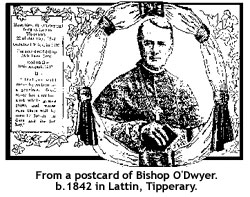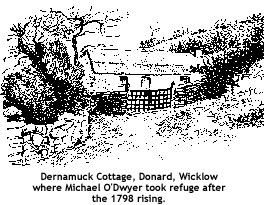| |
 |
Clan: O'Dwyer
Other branches of the clan: Dwyer, Dwyre, Dwier, Dwyar.
Irish Clan Name:Ó Duibhir.
O’Dwyer means dun or black.
Arms: Argent a lion rampant gules between three ermine spots.
Crest: A hand couped at the wrist and erect grasping a sword all proper.
Motto: Virtus sola nobilitas - virtue alone enobles. |
 |
 |
| |
From the seventh century until the Cromwellian Conquest a thousand years later, the O'Dwyers were settled in the present Barony of Kilnamanagh, a territory of about 100 square miles lying in the centre of County Tipperary between Cashel and Emly in the South and Thurles and Killaloe in the North. The clan leaders occupied fortified castles in Dundrum, Killinure and Clonyhorpe.
Beginning with the year 1100, for five generations the O'Dwyer Chiefs married daughters of O'Brien, Prince of Thomond (twice), O'Kennedy of Ormond (twice), O'Carroll of Ely (once). In about 1250 we find John O'Dwyer of Kilnamanagh marrying a daughter of de Burgo (Bourke), one of the early Norman conquerors. His son Anthony, in 1279, married Maria, daughter of Butler of the House of Ormond, the first of many alliances with the Ormond family.
This probably led to the first Earl of Ormond, in the exercise of his Palatinate rights, creating William O'Dwyer, the son of Cornelius, Baron of Kilnamanagh, in 1329. This title, though not used in the State Papers, is attached by the Office of Arms to all subsequent Chiefs down to the seventeenth century. This William O'Dwyer married a daughter of Mac-William Burke of the House of Clanricarde.
Dermot (Derby) O'Dwyer of Clonyhorpe, played a prominent part as Sheriff of Tipperary under the Earl of Ormond, in dealing with the final stages of the Desmond rebellion in his locality, and had a long struggle with the notorious Myler MacGrath, Anglican Archbishop of Cashel. He died in 1629 and was buried in Holy Cross cemetery in County Tipperary. After him the Chieftaincy passed to the family of his cousin from Dundrum. |
|
| |
The O'Dwyers (in Irish Ó Duibhir, descendant of Duibhir) were an important Sept in County Tipperary, though not comparable in power or extent of territory with the |
 |
|
| |
neighbouring great Septs. Their lands were in Kilnamanagh, a mountainous area lying between the town of Thurles and the County of Limerick. The O'Dwyers were always noted for their staunch resistance to English aggression and many are recorded in connection with this in medieval and early modern times. More recently, The Most Reverend Edward O'Dwyer (1842- 1917), the Bishop of Limerick, endeared himself to the people of Ireland by his brave stand on behalf of Sinn Féin and the men of 1916. In America Joseph O'Dwyer (1841 - 1898) was noted as a pioneer physician, particularly in regard to the treatment of diphtheria. William O'Dwyer (born 1890) also had a remarkable career: Starting as an emigrant labourer from County Mayo, he became Mayor of New York, and one of the most notable of United States ambassadors. A very full account of this Sept is given in " The O'Dwyers of Kilnamanagh", a book by Sir Michael O'Dwyer. |
|
| |
Philip O'Dwyer, the chief of his clan from 1629, and his cousin Anthony, were exempted from pardon for life in the Commonwealth Act of 1652, as punishment for the capture of Cashel in 1641. Both of them probably cheated the gallows by dying before the Cromwellian conquest. Philip was the last of the line, extending back for ten centuries, of Chiefs and Barons of Kilnamanagh. All the land of the O'Dwyers of Kilnamanagh and the large areas owned by them in adjoining Baronies were forfeited to the Cromwellians. A few thousand acres were granted to sixteen lesser members of the Sept transplanted to County Clare or Connacht and the rest were driven out.
After the Restoration, several of the Clan, and others who had followed Edmund O'Dwyer to Flanders, put forward their claims for the return of their property, as promised, but only one woman, "Mary Dwire" appears to have succeeded, and the grant to her cannot be traced. Some six of the O'Dwyers served as officers in King James II's Irish regiments, but the two brothers, John and William, who were most prominent on the Royalist side, carried on guerrilla warfare until Limerick fell. They then joined with Patrick Sarsfield and won distinction as soldiers of fortune. John O'Dwyer rose to high command in the Imperial service. He was ennobled by Charles VI in 1713, and was chosen as Governor to hold Belgrade against the Turks. William entered the Russian service and became an Admiral under the Empress Catherine in the Navy which Peter the Great had recently created. Doubtless a number of such O'Dwyers that were left, were among the 20,000 Irish soldiers that followed Sarsfield to France. |
|
|
A striking picture of the military careers of one family of the O'Dwyers abroad is derived from the genealogy furnished in 1776 by the Ulster Office of Arms in |
 |
|
| |
Dublin to Anthony O'Dwyer of Cadiz. He was a direct descendant of Edmund, younger brother of Philip the Chief, who died in 1593. This shows five brothers of one family, the sons of Thomas O'Dwyer, serving under four different standards - French, Spanish, Russian, and Austrian.
The records of the Irish Brigade in France show Richard and Jerry O'Dwyer as Captains in 1780 in Berwick's regiment. There were O'Dwyers serving in the Brigade till it was disbanded in 1791, when at least one joined the service of the Republic and became a General under Napoleon, dying at St. Malo, France in 1820.
The Cromwellian confiscation's, confirmed in the case of the O' Dwyers and nearly all other Irish Septs, had driven all that was left of the Sept out of their possessions in Kilnamanagh and the adjoining Barony of Clanwilliam. The new owners, for lack of English tenants, as most of the Cromwellian rank and file left for England after selling their grants to their officers, in many cases encouraged the old owners or their descendants to return as their tenants.
Several of the O'Dwyers thus drifted back to Kilnamanagh and the Hearth-Tax returns for 1665 show there were then forty-seven O'Dwyers. Others established themselves as tenants in Clanwilliam where the transplantation's had not been so wholesale, and where some of the Anglo-Irish, Ormond and other Butlers among them, had recovered their estates at the Restoration.
(text © Clann na hÉireann, 2000)
Annacarty is part of the ancestral home of the O'Dwyers and forms a stage of the Beara-Breifne Greenway which is based on the historic march of O'Sullivan Beara in 1603. |
|
| |
|
|
|
|
| |
|
|

